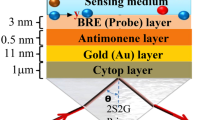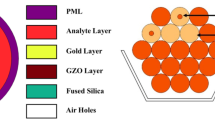Abstract
Wavelength interrogation surface plasmon resonance imaging (WSPRi) sensing has unique advantages in high-throughput imaging detection. The refractive index resolution (RIR) of WSPRi is limited to the order of 10−6 RIU. This paper demonstrates a novel WSPRi sensing system with a wavelength scanning device of an acousto-optic tunable filter (AOTF) and a low-cost speckle-free SPR excitation source of a halogen lamp. We developed a sensitive quasi-phase extraction method for data processing. The new technique achieved an RIR of 8.84×10−7 RIU, which is the first WSPRi system that has an RIR in the order of 10−7 RIU. Moreover, we performed a real-time recording of the formation of the coffee ring effect during brine evaporation and enhanced the biosensor performance of SPR for the first time. We believe the higher RIR and accuracy of the system will benefit more potential applications toward exploring the biomolecules’ behaviors in biological and biochemistry studies.
Graphical abstract









Similar content being viewed by others
References
Zhou J, Qi Q, Wang C, Qian Y, Liu G, Wang Y. Fu L Surface plasmon resonance (SPR) biosensors for food allergen detection in food matrices. Biosens Bioelectron. 2019;142:111449. https://doi.org/10.1016/j.bios.2019.111449.
Chen C, Wang J. Optical biosensors: an exhaustive and comprehensive review. Analyst. 2020;145(5):1605–28. https://doi.org/10.1039/c9an01998g.
Lertvachirapaiboon C, Baba A, Ekgasit S, Shinbo K, Kato K, Kaneko F. Transmission surface plasmon resonance techniques and their potential biosensor applications. Biosens Bioelectron. 2018;99:399–415. https://doi.org/10.1016/j.bios.2017.07.069.
Bockova M, Slaby J, Springer T, Homola J. Advances in surface plasmon resonance imaging and microscopy and their biological applications. Annu Rev Anal Chem (Palo Alto Calif). 2019;12(1):151–76. https://doi.org/10.1146/annurev-anchem-061318-115106.
Zeng Y, Hu R, Wang L, Gu D, He J, Wu S-Y, Ho H-P, Li X, Qu J, Gao BZ, Shao Y. Recent advances in surface plasmon resonance imaging: detection speed, sensitivity, and portability. Nanophotonics. 2017;6(5):1017–30. https://doi.org/10.1515/nanoph-2017-0022.
Wong CL, Olivo M. Surface plasmon resonance imaging sensors: a review. Plasmonics. 2014;9(4):809–24. https://doi.org/10.1007/s11468-013-9662-3.
Puiu M, Bala C. SPR and SPR imaging: recent trends in developing nanodevices for detection and real-time monitoring of biomolecular events. Sensors (Basel). 2016;16(6) https://doi.org/10.3390/s16060870.
Zeng Y, Wang X, Zhou J, Miyan R, Qu J, Ho HP, Zhou K, Gao BZ, Chen J, Shao Y. High-throughput imaging surface plasmon resonance biosensing based on ultrafast two-point spectral-dip tracking scheme. Opt Express. 2020;28(14):20624–33. https://doi.org/10.1364/OE.396656.
Yesudasu V, Pradhan HS, Pandya RJ. Recent progress in surface plasmon resonance based sensors: a comprehensive review. Heliyon. 2021;7(3):e06321. https://doi.org/10.1016/j.heliyon.2021.e06321.
Wang X, Zeng Y, Zhou J, Chen J, Miyan R, Zhang H, Qu J, Ho HP, Gao BZ, Shao Y. Ultrafast surface plasmon resonance imaging sensor via the high-precision four-parameter-based spectral curve readjusting method. Anal Chem. 2021;93(2):828–33. https://doi.org/10.1021/acs.analchem.0c03347.
Zeng Y, Wang L, Wu SY, He J, Qu J, Li X, Ho HP, Gu D, Gao BZ, Shao Y. Wavelength-scanning SPR imaging sensors based on an acousto-optic tunable filter and a white light laser. Sensors (Basel). 2017;17(1) https://doi.org/10.3390/s17010090.
Jia B, Chen J, Zhou J, Zeng Y, Ho H-P, Shao Y. Passively and actively enhanced surface plasmon resonance sensing strategies towards single molecular detection. Nano Res. 2022;15:8367–88. https://doi.org/10.1007/s12274-022-4515-z.
Qiu G, Gai Z, Tao Y, Schmitt J, Kullak-Ublick GA, Wang J. Dual-functional plasmonic photothermal biosensors for highly accurate severe acute respiratory syndrome coronavirus 2 detection. ACS Nano. 2020;14(5):5268–77. https://doi.org/10.1021/acsnano.0c02439.
Chen Y, Chen D, Liang S, Dai Y, Bai X, Song B, Zhang D, Chen H, Feng L. Recent advances in field-controlled micro–nano manipulations and micro–nano robots. Adv Intell Syst. 2021;4(3) https://doi.org/10.1002/aisy.202100116.
Collins DJ, Morahan B, Garcia-Bustos J, Doerig C, Plebanski M, Neild A. Two-dimensional single-cell patterning with one cell per well driven by surface acoustic waves. Nat Commun. 2015;6:8686. https://doi.org/10.1038/ncomms9686.
Chen J, Zeng Y, Zhou J, Wang X, Jia B, Miyan R, Zhang T, Sang W, Wang Y, Qiu H, Qu J, Ho HP, Gao BZ, Shao Y, Gu Y. Optothermophoretic flipping method for biomolecule interaction enhancement. Biosens Bioelectron. 2022;204:114084. https://doi.org/10.1016/j.bios.2022.114084.
Yang M, Chen D, Hu J, Zheng X, Lin Z-J, Zhu H. The application of coffee-ring effect in analytical chemistry. TrAC Trends in Analytical Chemistry. 2022;157 https://doi.org/10.1016/j.trac.2022.116752.
Sempels W, De Dier R, Mizuno H, Hofkens J, Vermant J. Auto-production of biosurfactants reverses the coffee ring effect in a bacterial system. Nat Commun. 2013;4:1757. https://doi.org/10.1038/ncomms2746.
Devineau S, Anyfantakis M, Marichal L, Kiger L, Morel M, Rudiuk S, Baigl D. Protein adsorption and reorganization on nanoparticles probed by the coffee-ring effect: application to single point mutation detection. J Am Chem Soc. 2016;138(36):11623–32. https://doi.org/10.1021/jacs.6b04833.
Zhang D, Gao B, Chen Y, Liu H. Converting colour to length based on the coffee-ring effect for quantitative immunoassays using a ruler as readout. Lab Chip. 2018;18(2):271–5. https://doi.org/10.1039/c7lc01127j.
Zang D, Tarafdar S, Tarasevich YY, Dutta Choudhury M, Dutta T. Evaporation of a droplet: from physics to applications. Physics Reports. 2019;804:1–56. https://doi.org/10.1016/j.physrep.2019.01.008.
Zeng Y, Zhou J, Sang W, Kong W, Qu J, Ho H-P, Zhou K, Gao BZ, Chen J, Shao Y. High-sensitive surface plasmon resonance imaging biosensor based on dual-wavelength differential method. Frontiers Chemistry.2021; 9. https://doi.org/10.3389/fchem.2021.801355
Miyan R, Wang X, Zhou J, Zeng Y, Qu J, Ho HP, Zhou K, Gao BZ, Chen J, Shao Y. Phase interrogation surface plasmon resonance hyperspectral imaging sensor for multi-channel high-throughput detection. Opt Express. 2021;29(20):31418–25. https://doi.org/10.1364/OE.433052.
Mampallil D, Eral HB. A review on suppression and utilization of the coffee-ring effect. Adv Colloid Interface Sci. 2018;252:38–54. https://doi.org/10.1016/j.cis.2017.12.008.
Routh AF. Drying of thin colloidal films. Rep Prog Phys. 2013;76(4):046603. https://doi.org/10.1088/0034-4885/76/4/046603.
Wang X, Zhang W, Wang S, Liu W, Liu N, Zhang D. A visual cardiovascular biomarker detection strategy based on distance as readout by the coffee-ring effect on microfluidic paper. Biochem Eng J. 2021; 176. https://doi.org/10.1016/j.bej.2021.108176
Wang D, Loo F-C, Cong H, Lin W, Kong SK, Yam Y, Chen S-C, Ho HP. Real-time multi-channel SPR sensing based on DMD-enabled angular interrogation. Opt Express. 2018;26(19):24627–36. https://doi.org/10.1364/OE.26.024627.
Sereda A, Moreau J, Canva M, Maillart E. High performance multi-spectral interrogation for surface plasmon resonance imaging sensors. Biosens Bioelectron. 2014;54:175–80. https://doi.org/10.1016/j.bios.2013.10.049.
Funding
This work was supported by the projects from the National Natural Science Foundation of China (Grant Nos. 62275164, 62275168, 11774071); the Guangdong Natural Science Foundation and Province Project (2021A1515011916); and the Shenzhen Key Laboratory of Photonics and Biophotonics (ZDSYS20210623092006020).
Author information
Authors and Affiliations
Corresponding authors
Ethics declarations
Conflict of interest
The authors declare no competing interests.
Additional information
Publisher’s note
Springer Nature remains neutral with regard to jurisdictional claims in published maps and institutional affiliations.
Rights and permissions
Springer Nature or its licensor (e.g. a society or other partner) holds exclusive rights to this article under a publishing agreement with the author(s) or other rightsholder(s); author self-archiving of the accepted manuscript version of this article is solely governed by the terms of such publishing agreement and applicable law.
About this article
Cite this article
Zeng, Y., Nie, Z., Kai, D. et al. Quasi-phase extraction-based surface plasmon resonance imaging method for coffee ring effect monitoring and biosensing. Anal Bioanal Chem 415, 5735–5743 (2023). https://doi.org/10.1007/s00216-023-04854-w
Received:
Revised:
Accepted:
Published:
Issue Date:
DOI: https://doi.org/10.1007/s00216-023-04854-w




